Table of contents
- Pascal Eckhardt’s driving tips for the racetrack Part 3 learning to read routes
- No excuses for a chat in the box!
- Outward sloping curves
- Elevated curves
- Inclines, crests and slopes
- The coach
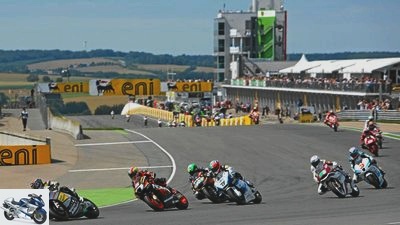
2snap

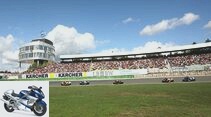
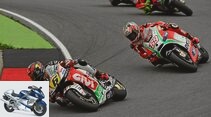

9 pictures

2snap
1/9
How can I use the road conditions for myself? After all, everyone is skiing on the same track, everyone will find the same track with identical requirements.
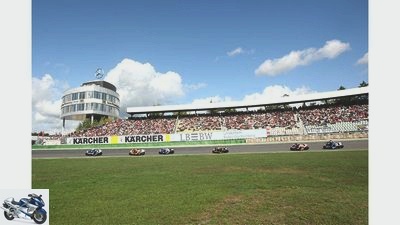
Racepixx
2/9
That’s only partly true, because you have to read the route first, recognize the conditions, and then adjust to it. We are therefore presenting three key points that are very common on racetracks.

2snap
3/9
Outward sloping curve: In such curves, extreme caution is required – it starts with the brakes. Decelerating as hard to the crown as usual is not possible. Stay in the lean position for as short a time as possible, straighten up quickly and then continue at full throttle. Try that out!
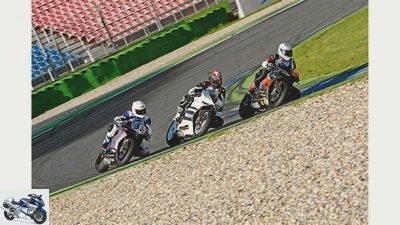
jkuenstle.de
4/9
Elevated curve: The Sachskurve is the favorite curve of so many racers, because you can drive into such extremely elevated curves really quickly and let yourself be squeezed into the saddle like in a jet. It takes a lot of effort, but a lot can be done.

2snap
5/9
Nasty in Le Mans: The inside of the curve is very elevated. If you have to take the outside lane, you will experience it hanging.
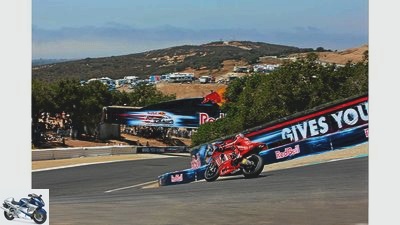
2snap
6/9
Slope: Laguna Secas “Corkscrew” is a prime example of slope, crest and hanging curve in one.
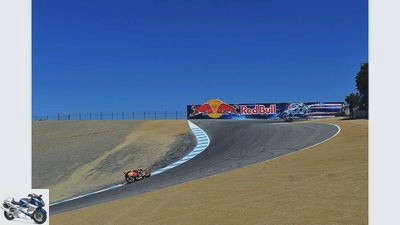
2snap
7/9
Similar to the “Corkscrew” (in the picture) applies to the Sachsenring behind the paddock: In the right downhill the motorcycle becomes light. You have to know that!
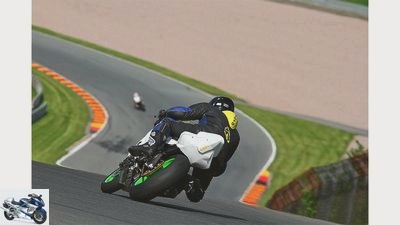
Racepixx.de
8/9
If the motorcycle gets too light over the crest: Leaning too long and accelerating hard at the same time can be dangerous.
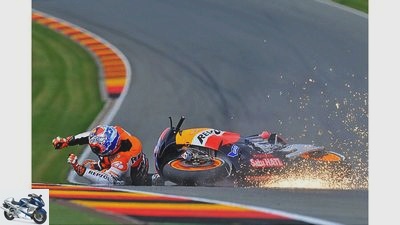
2snap
9/9
You see that a lot in the GP.
counselor
workshop
Driving tips for the racetrack part 3
Pascal Eckhardt’s driving tips for the racetrack
Part 3 learning to read routes
Content of
Not all racetracks are the same, and curves are not the same. If you look closely, you are faster. Part 3 of the driving tips series is about reading the route.
Pascal Eckhardt
04/30/2013
Why can the guy in front of me accelerate so early in the corner? Anyone who wants to go fast and, if possible, clings to a somewhat faster colleague, will have to ask themselves this question. To make it superficially easier, you could blame the other person’s better tires. The probability that the person in front is sitting on a BMW S 1000 RR is now also very high. “Yes, of course, it also has traction control”, would therefore also be a supposedly legitimate explanation.
Buy complete article
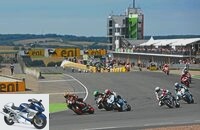
Pascal Eckhardt’s driving tips for the racetrack
Part 3 learning to read routes
4 pages) as PDF
€ 2.00
Buy now
No excuses for a chat in the box!
But we could go on forever, from the better suspension setup to special tire compounds. But to be honest: For me it sounds like disgraceful excuses on the one hand, and on the other – it weighs almost worse – you have somehow resigned yourself to being saddled up again and again. If that’s enough for you, then keep going in a circle and prepare the excuses for the evening chat in the box in good time.
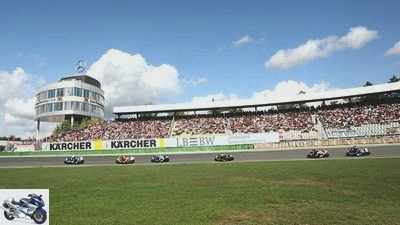
Racepixx
Only when inspecting the track can all the little things on the track be recognized so that they can then be implemented in the race.
Or, and now we come back to the question asked at the beginning, seriously think about what it could be. No question about it, when I was with IDM I didn’t just say once that the faster one had the tires with significantly more grip or the motorcycle with more power – sometimes rightly, sometimes wrongly. Or maybe it was just because my competitors prepared better for certain conditions. And that’s why they used the track conditions to their advantage. This is exactly what we want to take care of in this part of our series, in which everything currently revolves around preparation until you can finally test our practical tips in the next few parts.
But without the right preparation there is no real success and therefore back to the question: How can I use the road conditions for myself? After all, everyone drives on the same route, everyone finds the same slope with identical conditions. That’s only partly true, because you have to read the route first, recognize the conditions, and then adjust to it. So this time let’s take care of three key points that are very often found on race tracks and which, with the necessary basic knowledge, can be used to eat up seconds.

workshop
Pascal Eckhardt’s driving tips for the racetrack
Part 2: Mental preparation – why and then what?
read more
Outward sloping curves
Assuming that the situation mentioned at the beginning happens to you on the Sachsenring in the first right after the start / finish. This curve slopes down towards the outside. One also speaks of a negative angle of inclination or a hanging curve. The basic rule is: In such bends, stay in an inclined position as short as possible. Here the forces are simply working against us. Remember: the motorcycle becomes “light” in such situations and the tires have less grip.
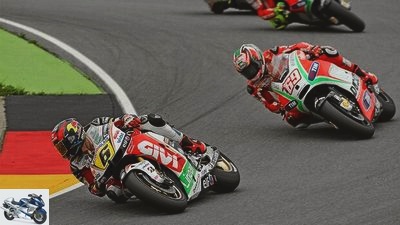
2snap
Outward sloping curve: In such curves, extreme caution is required – it starts with the brakes. Decelerating as hard to the crown as usual is not possible. Stay in the lean position for as short a time as possible, straighten up quickly and then continue at full throttle. Try that out!
So how can this be counteracted as best as possible? We should try to enter such a curve as vertically as possible. The point of maximum inclination must be as short as possible. So get up early again and then out of the corner with the gas tap fully open. Only in this way can we compensate for the negative angle of inclination. Attention: The process has to be exactly right. Anyone who does not precisely coordinate getting up and accelerating and rather muddles around rather than proceeding step by step risks taking off quickly. So slowly perfect the process, then pick up speed and feel the limit. If you keep that in mind, you will master such corners and are on the right track to step up here.
Elevated curves
Of course, there is also the opposite of the “hanging” curve. A prime example here is the Sachskurve on the Hockenheimring. Everyone knows them, everyone loves them. But why is it like that? Quite simply: the curve is enormously elevated, so it has a positive angle of inclination. Positive always sounds good and it actually helps us because it counteracts centrifugal force. If you look at the curve from your motorcycle, you don’t even notice the gradient towards the inside of the curve.
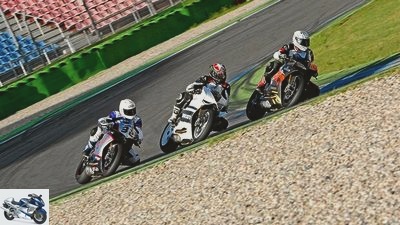
jkuenstle.de
Elevated curve: The Sachskurve is the favorite curve of so many racers, because you can drive into such extremely elevated curves really quickly and let yourself be squeezed into the saddle like in a jet. It takes a lot of effort, but a lot can be done.
But take a look at the curve in the evening when you walk through the track, and you’ll be amazed at how steep the thing is. One or the other also had to learn that with burnout at the end of the race, when the motorcycle literally slides down the “slope” and pulls the burnout hero along in front of the crowd there. For me it is amazing how it literally pushes you into a curve there. And it is precisely this “contact pressure” that we have to take advantage of. It starts as soon as you enter the bend. You can go into a banked corner a lot faster than you think. It takes some effort, but it works! On the other hand, you need significantly less lean angle for the same speed as in a “flat” curve. That should also be taken into account. All in all, excessive curves simply convey a lot of security and a good feeling. Use it!
Inclines, crests and slopes
Even if perfectly flat stretches have their very special charm, in my opinion stretches with inclines and declines are a real challenge – especially before curves. The Sachsenring is once again a good example of this – a circuit that pulls out all the stops to really challenge racing drivers.

2snap
Slope: Laguna Secas “Corkscrew” is a prime example of slope, crest and hanging curve in one.
We are approaching the last left before the start / finish. This is where most of the overtaking maneuvers take place on the MotoGP weekend. Why? Because things are really uphill here. If you set your braking point before a “flat” corner as late as before this corner, it is guaranteed to go wrong. As in the banked corners, the contact pressure increases here, so you can use your brakes much more due to the increased grip – without them locking. So anchor really late – that’s the total kick! You should also work your way up to this step by step. How exactly this is done will be a topic in one of the next issues when it comes to sounding out the right braking point. First of all, it is important to remember: If the going is uphill, you anchor very late.
When things go downhill, of course, the tide turns. The grip becomes less. In addition, the motorcycle becomes very light on the rear brakes, which is not helpful when braking late. You can only try to counteract this by changing your sitting position. There will also be a special chapter on this in our series. For today, the motto applies: Be careful when going downhill! Theoretically, you could work out a chassis setup that works perfectly for such a key point. But that won’t work well the rest of the way. The only thing left is the search for the right compromise. Hilltops are also a special experience. If you turn left at full throttle after the uphill section on the Sachsenring in a blind flight: really awesome! It is very important to know that there is very little grip because the motorcycle becomes very light on the crest and loses contact pressure. And you already know what little pressure means.
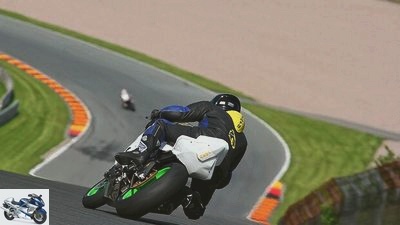
Racepixx.de
If the motorcycle gets too light over the crest: Leaning too long and accelerating hard at the same time can be dangerous.
What I really want to give you: As already described, it is very difficult to recognize the conditions when you rush across the track at speed. Take your time on a race weekend in the evening and go around the track. That really opens up a whole new perspective. Suddenly everything looks completely different. Also pay attention to the little things. Is the surface changing somewhere, are bumps or other peculiarities recognizable? If, for example, you have suspension problems at one point while driving, take a very close look at what’s on the track. If an edge is the trigger for the problem, look carefully to see whether the edge “rises” or “falls”, these are two pairs of shoes when setting the suspension.
As you will surely notice, such a racetrack and its nature is a very complex topic that cannot be dealt with exhaustively in every detail anyway. But you now know the most striking points to get faster. If there is still something burning under your fingertips on this topic, please let us know and write to me. The attentive reader will also have noticed that most of the route situations described here can be found on the Sachsenring. Indeed, it offers all conceivable challenges. That is exactly why we organize our V.I.P. training courses there. Let’s learn together there and have fun – I’m already looking forward to it!
The coach
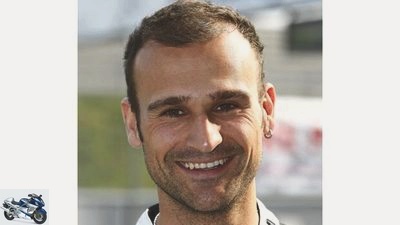
The coach: Pascal Eckhardt.
Pascal Eckhardt has been riding a motorcycle since childhood, but came to racing late. In 2003 he entered the Yamaha R6 Cup, was runner-up the following year and finally won the Cup in 2006. After that, Allgau Supersport competed in the IDM, celebrated several race wins and made it onto the podium countless times. In 2009, “Ecke” finished third in the IDM championship. At the 24 Hours of Oschersleben, he also achieved a podium in the PS team. In 2011 he hung up his professional helmet together with SKM teammate Christian Kellner. Until an accident last summer, Pascal was also a keen motocrosser. As an instructor, the 36-year-old will be back at the PS-V.I.P.-trainings in the 2013 season.
Related articles
-
Pascal Eckhardt’s driving tips for brakes
archive counselor workshop Pascal Eckhardt’s driving tips for brakes Pascal Eckhardt’s driving tips for the racetrack Part 6 – Brakes Content of If you…
-
Pascal Eckhardt’s driving tips for the racetrack part 5
archive counselor workshop Pascal Eckhardt’s driving tips for the racetrack part 5 Pascal Eckhardt’s driving tips for the racetrack Part 5 Correct…
-
Pascal Eckhardt’s driving tips for the racetrack Concentration
fact counselor workshop Pascal Eckhardt’s driving tips for the racetrack Concentration Pascal Eckhardt’s driving tips for the racetrack Part 11 Full…
-
Pascal Eckhardt’s driving tips for the racetrack part 4
escort elite 37 pictures Milagro 1/37 The GridGirls from the MotoGP weekend at the Sachsenring 2013. 2snap 2/37 The GridGirls from the MotoGP weekend at…
-
Pascal Eckhardt’s driving tips for the racetrack part 2
fotolia counselor workshop Pascal Eckhardt’s driving tips for the racetrack part 2 Pascal Eckhardt’s driving tips for the racetrack Part 2: Mental…
-
Pascal Eckhardt’s driving tips for the racetrack part 1
Wiebmann counselor workshop Pascal Eckhardt’s driving tips for the racetrack part 1 Pascal Eckhardt’s driving tips for the racetrack Part 1 introduction…
-
MOTORCYCLE tips for racetrack training
jkuenstle.de counselor workshop MOTORCYCLE tips for racetrack training Tips for newcomers to the racetrack Always nice and slow You’ve got your hands on…
-
Driving tips and advice on motorcycling
fact 26th pictures MOTORCYCLE 1/26 On the way on alpine passes? That’s how it works! MOTORCYCLE 2/26 Seductive winding curves with risk. The course of…
-
Service: Fit for the racetrack with the horsepower fitness tips
Seitz 14th pictures bird 1/14 …Flexibility in the leg area. Especially in street sports when hanging-off is indispensable. 2snap 2/14 Those who train…
-
Driving tips: Warm up the motorcycle properly
jkuenstle.de counselor workshop Driving tips: Warm up the motorcycle properly This is how it works: Warm up the motorcycle properly How to get your bike…